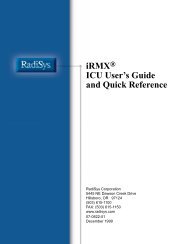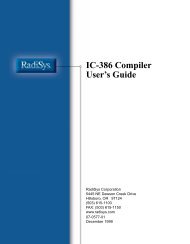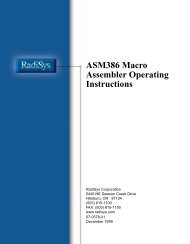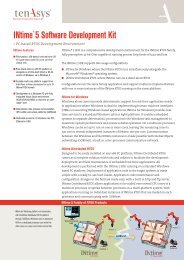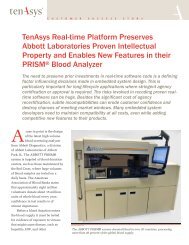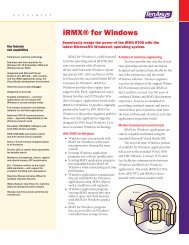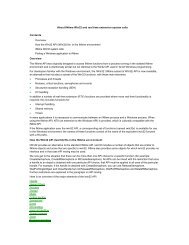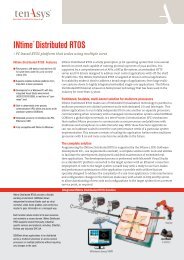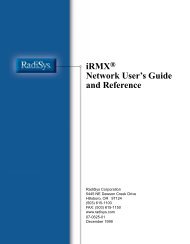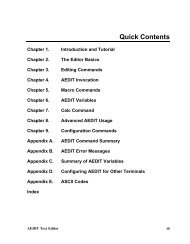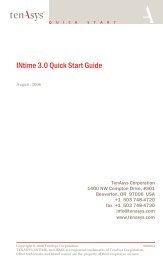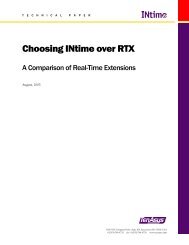INtime® 3.1 Software - tenAsys
INtime® 3.1 Software - tenAsys
INtime® 3.1 Software - tenAsys
You also want an ePaper? Increase the reach of your titles
YUMPU automatically turns print PDFs into web optimized ePapers that Google loves.
Chapter 5: Designing RT applications<br />
Interrupt and event processing<br />
Multi-tasking<br />
Interrupts and internal events occur at the bedside units: bedside personnel enter<br />
commands asynchronously and the system computes toxicity levels at regular<br />
intervals.<br />
Toxicity levels, measured as the blood enters the bedside unit, are not subject to abrupt<br />
change. The machine slowly removes toxins while the patient's body, more slowly,<br />
puts toxins back in. The result is a steadily declining toxicity level. The bedside units<br />
must monitor toxicity levels regularly, but not too frequently. For instance, the bedside<br />
units could compute the toxicity levels once every 10 seconds, using a clock for timing.<br />
The measurement thread would measure and compute the toxicity, put the information<br />
in a mailbox for the MCU, and suspend itself for 10 seconds.<br />
Command interrupts from the bedside unit occur when a medical operator types a<br />
command and presses Enter. Interrupts from command entries occur at random times.<br />
The interrupt handler signals the interrupt thread. The interrupt thread performs any<br />
required processing and waits for the next interrupt.<br />
Processing commands from the bedside units: Each time a medical operator types a<br />
command and presses Enter, the bedside unit receives an interrupt signal from the<br />
terminal. The bedside unit stops executing the current instruction and begins to<br />
execute an interrupt handler.<br />
1. The interrupt handler accumulates the characters in a buffer and puts them in<br />
memory. The interrupt handler signals the interrupt thread for bedside commands.<br />
2. The interrupt thread gets the contents of the memory where the handler put the<br />
command. It parses the command and does the required processing.<br />
3. The thread puts the command information, along with the number of the bedside<br />
unit, into a message.<br />
4. The thread sends the message to the predetermined mailbox for the MCU.<br />
5. The interrupt thread waits for the next interrupt. The system returns to its normal<br />
priority-based, preemptive scheduling.<br />
Threads in the application run using preemptive, priority-based scheduling. This<br />
allows the more important threads, such as those that control the dialysis rate, to<br />
preempt lower-priority threads, such as those that update displays. New capabilities<br />
can be added to the system by simply adding new threads.<br />
59



